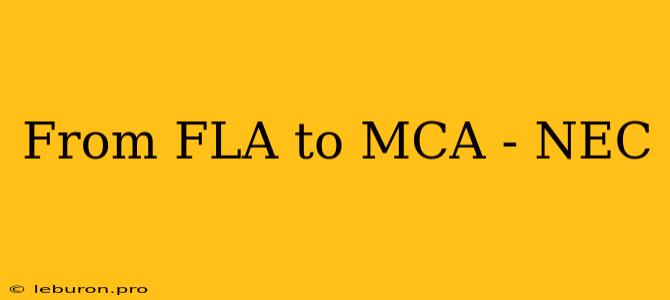The journey from FLA (Fiber to the Location) to MCA (Multi-Channel Access) is a crucial step in the evolution of broadband infrastructure, paving the way for faster internet speeds and improved connectivity. This transformation is driven by the need to accommodate the ever-increasing demands of data consumption, driven by factors such as streaming services, online gaming, and the rise of the Internet of Things (IoT). As network operators strive to meet these demands, the transition from FLA to MCA becomes an essential undertaking, requiring a comprehensive understanding of the technology, its implications, and the role of the NEC (National Electrical Code) in ensuring its safe and efficient implementation.
From FLA to MCA: Understanding the Shift
FLA (Fiber to the Location) describes a network architecture where optical fiber cable runs directly to the premises of individual subscribers. This approach offers significant advantages in terms of speed and capacity, making it ideal for delivering high-bandwidth services like Gigabit Ethernet. However, FLA can be costly to deploy, particularly in densely populated areas where extensive infrastructure upgrades may be required.
MCA (Multi-Channel Access) emerges as a more cost-effective solution for expanding broadband reach. It leverages existing infrastructure, such as coaxial cable, to deliver high-speed internet services alongside traditional cable TV offerings. MCA typically combines fiber optic and coaxial cable technology, allowing network operators to maximize existing infrastructure while delivering enhanced connectivity. This hybrid approach enables operators to offer flexible and scalable solutions, meeting the diverse needs of various subscribers.
The Role of NEC in MCA Implementation
The NEC (National Electrical Code) plays a crucial role in ensuring the safe and efficient deployment of MCA infrastructure. The NEC provides comprehensive guidelines for electrical wiring and equipment installations, covering aspects such as:
- Cable Installation: The NEC mandates specific requirements for the installation of coaxial cable and fiber optic cable, including proper grounding, shielding, and routing practices to ensure signal integrity and minimize interference.
- Equipment Safety: The NEC outlines safety standards for equipment used in MCA systems, including amplifiers, splitters, and other components, to prevent electrical hazards and ensure system reliability.
- Fire Safety: The NEC addresses fire safety considerations, particularly in relation to cable routing and installation, to minimize the risk of fire hazards associated with electrical wiring.
By adhering to the NEC, network operators can ensure that their MCA installations are compliant with industry standards, promoting safety, reliability, and efficient operation.
Benefits of the FLA to MCA Transition
The transition from FLA to MCA brings several significant advantages:
- Cost-Effectiveness: MCA offers a more cost-effective approach to expanding broadband reach, leveraging existing infrastructure and minimizing the need for extensive new deployments.
- Increased Bandwidth: MCA enables network operators to provide higher bandwidth capabilities, delivering faster internet speeds and improved user experiences.
- Flexible Deployment: MCA offers a flexible deployment model, allowing network operators to tailor solutions to meet the specific needs of different subscriber segments.
- Enhanced Reliability: MCA systems, with their hybrid approach, are often more reliable and resilient than traditional FLA deployments, minimizing service disruptions and downtime.
Addressing the Challenges
The shift from FLA to MCA also presents challenges:
- Legacy Infrastructure: Upgrading legacy infrastructure, such as coaxial cable networks, to accommodate MCA technology can be a complex and resource-intensive process.
- Technical Expertise: Implementing MCA requires specialized technical expertise in both fiber optic and coaxial cable technologies, creating a need for skilled professionals.
- Competition: The rise of MCA has intensified competition among network operators, creating a dynamic environment with ongoing technological advancements and evolving market dynamics.
The Future of FLA and MCA
The FLA and MCA approaches represent different points on a continuum of broadband network evolution. While FLA remains the gold standard for high-speed internet, MCA offers a more cost-effective and flexible approach, particularly for expanding broadband access to underserved communities.
As technology continues to advance, we can expect further innovations in the FLA and MCA domains. Fiber optic technologies continue to improve, offering higher speeds and greater capacity. Similarly, MCA solutions are being refined, incorporating advanced technologies such as DOCSIS 4.0, which delivers multi-gigabit internet speeds over existing coaxial infrastructure.
The ongoing transition from FLA to MCA is driven by the constant demand for faster internet speeds and improved connectivity. By embracing MCA technology and adhering to the guidelines outlined in the NEC, network operators can ensure a safe, reliable, and efficient deployment of broadband infrastructure, paving the way for a future where internet access is available to all.
